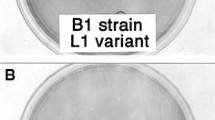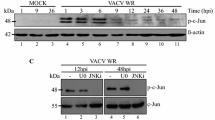Abstract
Epidermal growth factor (EGF) and transforming growth factor type I (TGF) are polypeptides of 53 and 50 amino acid residues, respectively1,2. Both bind to EGF receptor, a 1,200-residue transmembranous glycoprotein3, leading to phosphorylation of the receptor, enhancement of its tyrosine-specific kinase activity and ultimately to stimulation of cell growth4,5. We report here that a 140-residue polypeptide encoded by one of the early genes of vaccinia virus (VV)6 is related closely to EGF and TGF. The presence of putative signal and transmembranous sequences further suggests that the viral protein might be an integral membrane protein, but that, as in the case of EGF itself7,8, the membrane-associated form may be the precursor of a soluble growth factor. Production of EGF-like growth factors by virally infected cells could account for the proliferative diseases associated with members of the poxvirus family such as Shope fibroma virus9, Yaba tumour virus10, and molluscum contagiosum virus (MCV)11.
Similar content being viewed by others
References
Carpenter, G. & Cohen, S. A. Rev. Biochem. 48, 193–216 (1979).
Marquardt, H., Hunkapiller, M. W., Hood, L. E. & Todaro, G. J. Science 223, 1079–1082 (1984).
Ullrich, A. et al. Nature 309, 418–425 (1984).
Cohen, S. in Biological Response Mediators and Modulators (ed. August, J. T.) 7–12 (Academic, New York, 1983).
Tam, J. P., Marquardt, H., Rosberger, D. F., Wong, T. W. & Todaro, G. J. Nature 309, 376–378 (1984).
Vankatesan, S., Gershowitz, A. & Moss, B. J. Virol. 44, 637–646 (1982).
Scott, J. et al. Science 221, 236–240 (1983).
Gray, A., Dull, T. J. & Ullrich, A. Nature 303, 722–725 (1983).
Shope, R. E. J. exp. Med. 56, 793–822 (1932).
Niven, J. S. F., Armstrong, J. A., Andrewes, C. H., Pereira, H. G. & Valentine, R. C. J. Path. Bact. 81, 1–14 (1961).
Postlethwaite, R. Archs envir. Hlth 21, 432–452 (1970).
Gregory, H. & Preston, B. M. Int. J. Peptide Protein Res. 9, 107–118 (1977).
Marquardt, H. et al. Proc. natn. Acad. Sci. U.S.A. 80, 4684–4688 (1983).
Doolittle, R. F., Feng, D. F. & Johnson, M. Nature 307, 558–560 (1984).
Russell, D. W. et al. Cell 37, 577–585 (1984).
Savage, C. R., Hash, J. H. & Cohen, S. J. biol. Chem. 248, 7669–7692 (1973).
Chou, P. Y. & Fasman, G. D. A. Rev. Biochem. 47, 251–276 (1978).
Rouhandeh, H. & Vafai, A. Virology 120, 71–92 (1982).
Koziorowska, J., Wlodarski, K. & Mazurowa, N. J. natn. Cancer Inst. 46, 225–241 (1971).
Barbanti-Brodano, G., Mannini-Palenzona, A., Varoli, O., Portolani, M. & La Placa, M. J. gen. Virol. 24, 237–246 (1974).
Waterfield, M. D. et al. Nature 304, 35–39 (1983).
Downward, J. et al. Nature 307, 521–527 (1984).
Blomquist, M. C., Hunt, L. T. & Barker, W. C. Proc. natn. Acad. Sci. U.S.A. 81, 7363–7367 (1984).
Author information
Authors and Affiliations
Rights and permissions
About this article
Cite this article
Brown, J., Twardzik, D., Marquardt, H. et al. Vaccinia virus encodes a polypeptide homologous to epidermal growth factor and transforming growth factor. Nature 313, 491–492 (1985). https://doi.org/10.1038/313491a0
Received:
Accepted:
Issue Date:
DOI: https://doi.org/10.1038/313491a0
- Springer Nature Limited
This article is cited by
-
The Oncolytic Poxvirus JX-594 Selectively Replicates in and Destroys Cancer Cells Driven by Genetic Pathways Commonly Activated in Cancers
Molecular Therapy (2012)
-
Expression of epidermal growth factor and its receptor in normal and diseased human kidney: An immunohistochemical and in situ hybridization study
Kidney International (1996)
-
Changes in epidermal Langerhans cells, γδ T cells and CD4 T cells after intradermal infection with recombinant vaccinia virus expressing cytokine genes
Immunology & Cell Biology (1994)
-
Epidermal growth factor-related peptides in the pathogenesis of human breast cancer
Breast Cancer Research and Treatment (1994)





